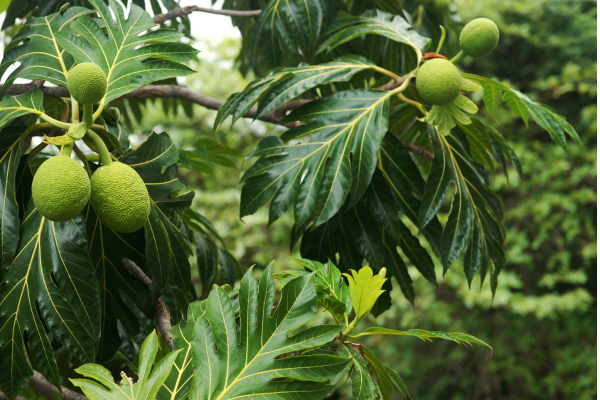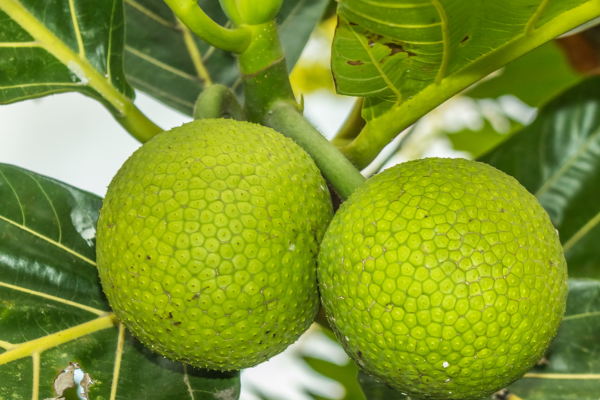The Ceylon Breadfruit Tree – By Nadeeka – eLanka

The Ceylon breadfruit tree (Artocarpus altilis) is a significant part of the agricultural and cultural heritage of many tropical regions, particularly in Sri Lanka, where it is commonly known as “del” or “wal del.” This article delves into the rich history of the breadfruit tree, its diverse uses, the numerous health benefits it offers, and provides a selection of delicious recipes that showcase its versatility.
Historical Background
Origins and Spread
The breadfruit tree is believed to have originated in the South Pacific region, specifically in the area around New Guinea and the Indo-Malay Archipelago. From there, it spread throughout the tropics, carried by Polynesian voyagers who valued the tree for its ability to provide a reliable food source during long sea voyages. By the time European explorers arrived in the Pacific, breadfruit was already a staple food across many islands.
Introduction to Ceylon (Sri Lanka)
The breadfruit tree was introduced to Ceylon (now Sri Lanka) by the British in the late 18th century. Captain William Bligh, famous for the mutiny on the HMS Bounty, played a crucial role in transporting breadfruit saplings from Tahiti to the Caribbean, and later to other British colonies, including Ceylon. The tree thrived in the island’s tropical climate and quickly became an integral part of local agriculture and cuisine.
Botanical Description
The breadfruit tree is a fast-growing evergreen tree that can reach up to 26 meters in height. It has large, glossy, dark green leaves that are deeply lobed and can be up to 60 cm long. The tree produces large, round to oval fruits that can weigh up to 3.5 kg. The fruit’s skin is rough and green, turning yellowish or brownish when ripe, and the flesh inside is creamy white or yellow, with a starchy texture.
Uses of Breadfruit
Culinary Uses
Breadfruit is incredibly versatile in the kitchen. It can be roasted, baked, fried, boiled, or steamed, and its texture and flavor change depending on how it is cooked.
- Roasting: Roasting is one of the simplest and most popular ways to prepare breadfruit. The fruit is often roasted whole over an open flame or in an oven until the skin is charred and the flesh inside is soft and aromatic.
- Boiling: Boiled breadfruit is commonly used in soups and stews, where it absorbs the flavors of the broth and other ingredients.
- Frying: Sliced breadfruit can be fried to make chips or fritters, which are crispy on the outside and soft on the inside.
- Baking: Breadfruit can also be baked in a similar way to potatoes, often seasoned with herbs and spices for added flavor.
Non-Culinary Uses
In addition to its culinary uses, the breadfruit tree has several non-culinary applications:
- Wood: The wood of the breadfruit tree is lightweight yet strong, making it suitable for building canoes, furniture, and houses.
- Latex: The tree produces a sticky latex that can be used as a natural adhesive or sealant.
- Leaves: The large leaves can be used as natural wrappers for food or as plates.
Health Benefits
Breadfruit is not only a versatile food but also a nutritious one. It offers numerous health benefits due to its rich nutritional profile.
Nutritional Content
Breadfruit is a good source of complex carbohydrates, dietary fiber, vitamins, and minerals. A typical serving of breadfruit provides:
- Carbohydrates: Breadfruit is high in complex carbohydrates, which provide sustained energy.
- Dietary Fiber: The high fiber content helps promote healthy digestion and can aid in weight management.
- Vitamins: Breadfruit is rich in vitamins C and A, which are essential for immune function and eye health.
- Minerals: It contains significant amounts of potassium, which is important for heart health, and magnesium, which supports muscle and nerve function.

Health Benefits
- Digestive Health: The dietary fiber in breadfruit helps regulate bowel movements and prevent constipation.
- Heart Health: The potassium content helps lower blood pressure, reducing the risk of heart disease.
- Immune Support: The high levels of vitamin C boost the immune system and help the body fight off infections.
- Antioxidant Properties: Breadfruit contains antioxidants that help neutralize harmful free radicals in the body.
Recipes
Here are some delicious breadfruit recipes that highlight its versatility:
Breadfruit Chips
Ingredients:
- 1 medium breadfruit
- 2 cups vegetable oil
- Salt to taste
Instructions:
- Peel the breadfruit and cut it into thin slices.
- Heat the oil in a deep frying pan over medium-high heat.
- Fry the breadfruit slices in batches until they are golden brown and crispy.
- Drain on paper towels and season with salt. Serve warm.
Breadfruit Curry
Ingredients:
- 1 medium breadfruit, peeled and cut into cubes
- 2 tablespoons vegetable oil
- 1 onion, finely chopped
- 2 garlic cloves, minced
- 1 tablespoon curry powder
- 1 teaspoon turmeric
- 1 teaspoon cumin
- 1 can (400 ml) coconut milk
- Salt and pepper to taste
- Fresh cilantro for garnish
Instructions:
- Heat the oil in a large pot over medium heat. Add the onion and garlic, and sauté until soft.
- Stir in the curry powder, turmeric, and cumin, and cook for another minute.
- Add the breadfruit cubes and stir to coat with the spices.
- Pour in the coconut milk and bring to a simmer. Cook until the breadfruit is tender, about 20 minutes.
- Season with salt and pepper. Garnish with fresh cilantro before serving.
Breadfruit Pudding
Ingredients:
- 2 cups breadfruit, cooked and mashed
- 1 cup coconut milk
- 1/2 cup sugar
- 1/4 cup cornstarch
- 1 teaspoon vanilla extract
- 1/2 teaspoon ground nutmeg
Instructions:
- Preheat the oven to 350°F (175°C).
- In a large bowl, combine the mashed breadfruit, coconut milk, sugar, cornstarch, vanilla extract, and nutmeg. Mix well.
- Pour the mixture into a greased baking dish.
- Bake for 30-35 minutes, or until the pudding is set and golden brown on top.
- Allow to cool before serving.
Cultural Significance
Breadfruit holds a special place in the cultures of many tropical regions. In Sri Lanka, it is often associated with traditional celebrations and rituals. The tree is also a symbol of abundance and sustenance, reflecting its importance as a reliable food source.
Environmental Impact
Breadfruit trees are environmentally beneficial. They are hardy and resilient, capable of growing in poor soil conditions, and require minimal maintenance. Their extensive root systems help prevent soil erosion, and they provide shade and habitat for other plants and animals.
Challenges and Opportunities
While breadfruit offers many benefits, there are also challenges associated with its cultivation and use. These include:
- Pest and Disease Management: Breadfruit trees can be susceptible to pests and diseases, which can impact fruit production.
- Post-Harvest Handling: Proper handling and storage are crucial to prevent spoilage, as breadfruit is highly perishable.
- Market Development: There is potential for developing new markets for breadfruit products, both locally and internationally.
Conclusion
The Ceylon breadfruit tree is a remarkable plant with a rich history and numerous uses. Its nutritional benefits, versatility in cooking, and cultural significance make it a valuable asset to tropical regions. As interest in sustainable and nutritious food sources grows, breadfruit has the potential to play an even greater role in global agriculture and cuisine.
Incorporating breadfruit into your diet not only provides health benefits but also supports sustainable agricultural practices. Whether you enjoy it roasted, boiled, fried, or baked, breadfruit is a delicious and nutritious addition to any meal.







